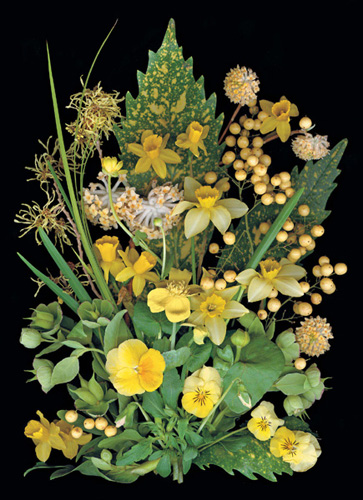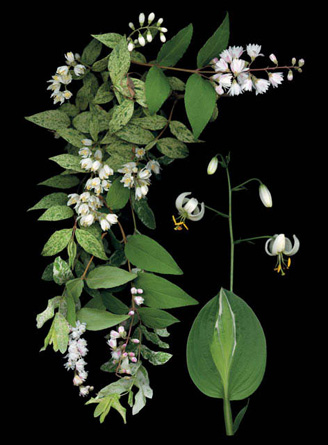
A monochromatic combination from Louise Wrinkle’s Alabama garden in winter include (clockwise from top left) witch hazel; yellow spattered leaves of evergreen shrub Aucuba japonica ‘Variegata’; daffodils; globe clusters of Edgeworthia chrysantha ‘Winter Gold’; berries of heavenly bamboo Nandina domestica ‘Leucocarpa’; pansies; yellow-green Helleborus foetidus fruits; and Caltha palustris.

After the writer and renowned gardener Vita Sackville-West created her all-white garden at Sissinghurst Castle in England, a trend began that continues today. A white planting could include snow white and cream to ivory. An all-white arrangement is not hard to create, and even easier to shop for—simply scan catalogs for annuals, perennials, shrubs, and even trees with flowers in that color throughout the seasons and variegated foliage in green and white. But you must deadhead the fading flowers, because brown shows up quickly against the white and detracts from the intended result.
One could choose to stick very carefully to the single-color notion, which would alter as the growing season progressed. An all-pink garden could be achieved with a succession of plants that bloom in that frequently available color. Or, variations on the single color could be allowed so that bright pink might join the arrangement with fuchsia, shocking pink, and rose. A monochromatic color scheme could zero in on one hue and create contrast between pastels and shades, and from flower texture and size, while also taking into account the times that they bloom. Shades, almost like shadow plantings, might bring in rich crimson, burgundy, and subdued maroon.
The focus here is on versions of a single color, and in all cases leaves play their part. For red, white, yellow, and even blue arrangements, berries might be useful. Remember that twigs too have their colors, and for the yellow and white monochromatic arrangements, variegation with gold, yellow, or silver and white on green could make an appearance playing the role of dappled light.
(Clockwise from top left) Deutzia gracillis ‘Variegata’; D. scabra; Lilium martagon ‘Album’; Hosta ‘Striptease’; Salix integra ‘Hakuro Nishiki’.

An area with perennial plantings at Frank Cabot’s Les Jardins de Quatre-Vents, located in La Malbaie in Québec, Canada, features a monochromatic blue border.